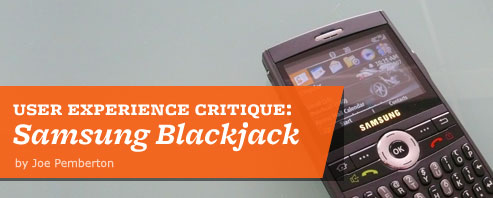
Carrier: AT&T (formerly Cingular)
Manufacturer: Samsung
Platform/OS: Windows Mobile 5
We can’t help the fact that mobile devices are often presented in retail environments with dummy mockups and fake printed screens. But, we can help the dialogue with a focus on the whole user experience and not merely a features and form factor breakdown.
The Blackjack is a conversation starter. It’s small, it’s capable and it’s good looking in a utilitarian kind of way. When people inevitably ask about it and I’m forced to explain my love/hate relationship with it.
For the good, the bad, the ugly, odd and puzzling keep reading after the bump. Continue Reading »
Add this to digg, del.icio.us, etc.

This is a real text message from Cingular. (I’m sure my phone is in their database from last season when my daughters voted for Ms. McPhee.)
But, I couldn’t believe this jumble of text. I have no doubt 16 year olds could probably understand it… but I question whether that still makes it smart marketing. Does bad language and incoherent punctuation add street cred? Do they do it because they believe users won’t scroll?
The haphazard punctuation — sometimes a comma, sometimes a period, sometimes nothing — is the icing on the cupcake. Why push the boundaries of language this far into the downright ludicrous? Are they trying to cut character count to save on data transfers? I don’t get it.
Add this to digg, del.icio.us, etc.
There has been a lot of press and commentary on Apple’s iPhone. Deservedly so. From what has been presented thus far the iPhone is a sleek piece of hardware and software engineering as only Apple can produce it. Whether the iPhone is revolutionary, expected or somewhere in between, the discussion has focused primarily on the device’s features and interface. Much less has been said about the implications of Apple’s iPhone business strategy. Since the iPhone was announced on January 9, my thoughts have turned to the decisions that Apple has had to make in order to enter the wireless market and what may come in the wake of the iPhone’s June 2007 launch.
Why iPhone?
Apple’s decision to get into the wireless device business is not surprising. Since the launch of the iPod 5 years ago, Steve Jobs has touted the connected experience where all Apple devices and services work and play seamlessly with one another in one glorious digital ecosystem. Since the mobile phone has become the one device that no one is ever without, despite the fact that nothing about the wireless experience is very good, it was only a matter of time before Apple got into the game. “Everybody hates their phone,” Time magazine quotes Jobs as saying, “and that’s not a good thing. And there’s an opportunity there.”
Uncharted Territory
Having decided to get in the game, Apple’s most significant decision is to be a manufacturer only rather than a manufacturer + MVNO. This is curious since Apple’s brand is largely based on its control of the end-to-end consumer experience. The MVNO route would have allowed Apple to maintain the most control over the end-to-end iPhone experience, clearly important after the ROKR fiasco. However, it would also have taken Apple into uncharted territory as a wireless operator. With iPhone v.1 Steve Jobs has decided to take the path with the fewest risks and stick with what he knows Apple does best.
Continue Reading »
Add this to digg, del.icio.us, etc.
The web is blowing up today with content on the new iPhone. It seems everyone has a perspective, and I’m no different.
Revolutionary or not, Apple did a few things right with this iPhone debut, which I’m convinced will resonate with today’s mobile users.
Portrait-landscape orientation: As media enjoyment and management grows on the mobile platform, mobile users have had to accommodate that awkward moment when you have to physically pivot the handset in your hands in order to view an image or watch mobile TV. In those instances, there is often a sense of disorientation while the user remaps expectations for the D-Pad, and explores how to interact with softkeys, etc. By creating a device that orients itself and keeps tactile interactions consistent, they’ve created a device that feels native to both orientations.
Continue Reading »
Add this to digg, del.icio.us, etc.
I’ve tried to separate myself from my Apple fetishism, and slough off Jobs’ reality-distortion effect and really assess this mornings’ announcement from the perspective of it’s impact on mobile user experience. (Certainly, a true UI critique will occur once we can get a device in hand in *sigh* June.
At the end of his keynote this morning, Steve Jobs summed up Apple’s mobile strategy saying, “There’s an old Wayne Gretsky quote I love — ‘I skate to where the puck is going to be, not to where it’s been.’” Which felt apropos given the product they had just announced. But, is the Apple iPhone announcement truly a “revolution of the first order?”
My take is that this is not a revolution for mobile phones. No, it feels more like catching up in a major way in an industry that has been behind far too long. Features like push email are best practices (read: Blackberry), not revolutionary. Integrating mail, voicemail, sms, contacts, voice calls, photos, music and video is also not revolutionary, but Apple is able to realize it where others have not.
Continue Reading »
Add this to digg, del.icio.us, etc.


